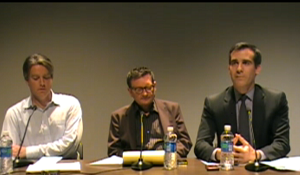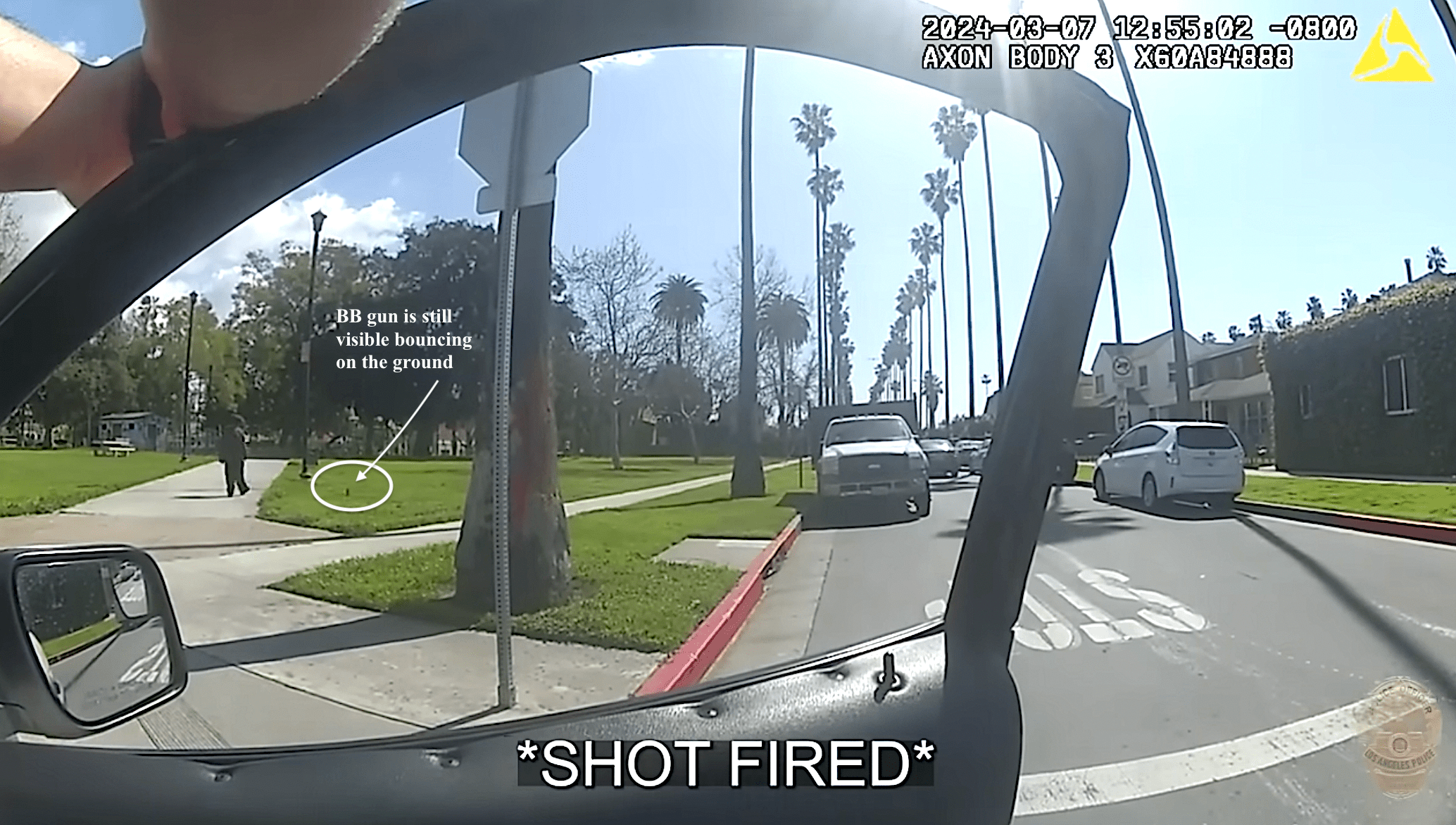Garcetti Commits to Small Ideas, Big Festivals, and Regular CicLAvias
8:26 AM PDT on March 19, 2012
The election is still a year away and already the campaign promises are flying!
This past friday evening, Mayoral Candidate Eric Garcetti joined Bill Roschen, President of LA’s Planning Commission, and Christopher Hawthorne, Architecture Critic for the LA Times, in a fast-paced conversation that was full of poetry, philosophy, and campaign promises.
When asked what it would take to make CicLAvia a regular event, Garcetti went where no other candidate had gone, he offered a commitment.
“The easiest way to make CicLAvia permanent is to elect me Mayor, ‘cause I’m going to make it permanent,” Garcetti said, “I want to see it regularized, at least once a month. I want to see roving CicLAvias in other parts of the city.”
Garcetti acknowledged that “There’s something happening out there!” and pointed at Silver Lake’s Sunset Triangle Plaza, LA's first street-to-plaza conversion, as evidence that little projects can have a big impact on a community.
“I want to be the sort of Mayor who is going to partner with communities,” Garcetti explained, “ to find out the individual needs and logic of any neighborhood and to make those dreams possible.”
Garcetti wasn’t shy about embracing the legacy of others. He addressed the need to look at the built environment by looking at the human experience and quoted Dostoevsky, “It’s easy to love humanity, the difficult part is learning to embrace your neighbor.”
When pointing at the need for reform within City Hall, he embraced his inner Dr. Seuss and said “The main mode of politics is to say ‘No, Slow, Make it Low and we have an opportunity to Go!’”
Garcetti pointed to the auto-centric Los Angeles that he experienced while growing up, one that was based on private spaces, backyards, cars, schools with kids on buses, and a private sector that served the needs of the community.
“It no longer works,” he charges, pointing to his densely populated district with few parks, gang activity, disconnected residents, empty storefronts as the embodiment of this principle. “We’re confronting this failure by emerging from our private space. This a snapshot of what our city will look like.”
Surrounded by architects, planners, and designers, Garcetti rose to the occasion and waxed poetic, recounting his childhood impression of LA’s skyline at night as “a bed of jewels that lays out before us.”
Garcetti introduced his theory of urban acupuncture, explaining that little improvements are catalytic and make the whole neighborhood feel better. “I always start planning with the community,” he explains, “for example in Sunset Junction we addressed homelessness, fixed the fountain, and added bike racks. The idea is to a feeling of limitless space.”
When asked how he overcomes resistance, Garcetti gave a nod to Jackie Goldberg who taught him not to dismiss people’s fears, “You must recognize and feel the fear to move past it.”
Garcetti avoided third rail topics such as the Hollywood Community Plan by reframing the debate and articulating the need to replace a plan from the past with one that accommodates the Hollywood of the future, “one that supports our new bike culture.”
As for the debate over skyscrapers and density, Garcetti countered by pointing at the negative impact of “yardscrapers” and “horizontal density.”
Garcetti is nimble as he gracefully introduces accomplishment after accomplishment from the past decade, yet champions the need for reform within City Hall. He As he looked back at his tour of duty as City Council President, a role he referred to as Group Therapist, it is clear that he intends to include civic therapy in his approach to civic engagement.
From encouraging members of the city family to fail forward to encouraging the public to express their inner fears, Garcetti is full of ideas that are designed to change the way the City of LA gets things done. “The big ideas are small ideas, the big ideas come from experimenting and using the city as a platform.”
Garcetti points to neighborhood after neighborhood as examples of how little ideas had big impacts and resonated as standards that can be implemented citywide.
“In Frogtown, we tore up the street, built a bioswale, rebuilt the street so that it had a water reclamation element with a park at the end, and established LA’s Green Street standard.”
“In Silver Lake, we moved the fence around the Reservoir so that people could enjoy the meadow, now people picnic, children fly kites, and public space brings people together.”
“In Atwater Village, we introduced parking credits so that businesses could share parking facilities, allowing the local economy to prosper by using underutilized space.”
Garcetti addressed the Mayor’s role on the Metro Board by pointing to the four seats that LA controls and addressing the need to build effective relationships and by focusing on the mass transit passenger’s experience, a callback to his human perspective approach to urban planning.
In an evening that was literally a Garcetti monologue with gentle prompts from Roschen and Hawthorne, the conversation was punctuated with murmurs of audience approval at each of the many references to community gardens, walkable streets, pocket parks, wayfinding, river paths, bike racks, and shoutouts to audience members.
Garcetti was challenged on the demise of the CRA, on the abundance of billboards, and on LA’s aged zoning Code, topics that he artfully handled, dispensing with them quickly and shifting the conversation to higher ground.
In a room full of planning and design professionals, Garcetti avoided allowing the conversation to get too technical or political and kept if aspirational and true to his stated conviction that the human perspective was most important.
When asked about the governance of other great cities, he passed on the internal machinations of City Halls and instead pointed to public art, bus rapid transit, bike sharing, festivals, walkable streets, great restaurants and other human scale experiences that transform a city.
Garcetti wrapped the evening with his Measure R promise, to not only pursue America Fast Forward, but to leverage the local return funds so that the City of LA could bond it and use the money now, resulting in 1600 miles of repaved streets.
Lest the discussion of bonds, interest rates, and cost increases harsh the vibe in the room, Garcetti followed up the Measure R nod by positioning “cool” as the element that stirs interest, attracts investment, stimulates growth, and revitalizes communities. “We must use good design to make our neighborhoods great.”
Garcetti is one of twelve declared candidates for Mayor of Los Angeles and the election is approximately a year away.
Stay in touch
Sign up for our free newsletter
More from Streetsblog Los Angeles
LAPD shoots, strikes unarmed unhoused man as he walks away from them at Chesterfield Square Park
LAPD's critical incident briefing shows - but does not mention - that two of the three shots fired at 35yo Jose Robles were fired at Robles' back.
Metro Committee Approves 710 Freeway Plan with Reduced Widening and “No Known Displacements”
Metro's new 710 Freeway plan is definitely multimodal, definitely adds new freeway lanes, and probably won't demolish any homes or businesses
Automated Enforcement Coming Soon to a Bus Lane Near You
Metro is already installing on-bus cameras. Soon comes testing, outreach, then warning tickets. Wilshire/5th/6th and La Brea will be the first bus routes in the bus lane enforcement program.





